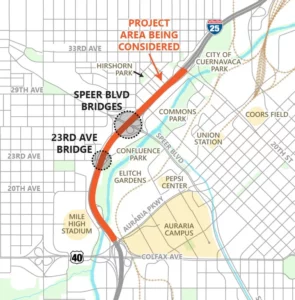By Gannon Rothman
Despite being a gateway to downtown Denver, the bridge on Speer Boulevard is most notable for its shattered concrete and exposed rebar. In a stakeholder meeting that was held in December 2021 with the Colorado Department of Transportation (CDOT), the deck conditions were given a poor rating, with load capacity and clearance not meeting the state’s standards.
Since then, CDOT has been looking into replacing the bridges at 23rd Avenue and Speer Boulevard. A list of proposed improvements has been added that includes upgrades to pedestrian and bicyclist safety, higher clearance and improved mainline flow coming from I-25.
So far, preliminary designs are the only way to see what the project will address. Constructed in the 1950s, the two bridges have the lowest clearance heights on all of I-25. This creates issues for drivers with vehicles too tall to go under these bridges, forcing them to divert around traffic and away from the regional highway. The December meeting also addressed several overpasses that reported the highest mainline incidents for on- and off-ramps coming from north and southbound I-25.
The bridges with the most incidents reported included Speer Boulevard and 23rd Avenue. Meanwhile, growth around I-25 is expected to increase to 15% through 2040, according to CDOT’s report. Jefferson Park United Neighbors (JPUN) has been interested in the project potentially affecting the neighborhood, and the organization’s president has been trying to get CDOT’s attention for some time.

“It’s just not a Jefferson Park issue. It’s a gateway issue. There is a need to utilize that transportation option,” said Michael Guiietz, president of JPUN. “The city can’t preach that there has to be density without providing multi-mobile transportation options for residents.”
CDOT’s timeline for the project is not set in stone either, with construction possibly starting this summer. Presley Fowler, the Region 1 deputy communications manager for CDOT, reminded people that this project is still in its “study” phase.
“The project is in a preliminary design (phase),” Fowler said. “We’re analyzing existing conditions. It’s like studying the highway.”
The project is using details from existing conditions and proposed alternatives from the I-25 Central Planning and Environmental Linkages (PEL) study to develop an effective solution that not only remedies current problems, but will align with the future vision for the interstate corridor and the surrounding area and community.
“We’ve been promised this since at least 2019 that this was going to start getting engaged, and it’s disheartening to hear that after all this time they’re still stalling and reviewing costs,” Guiietz said. “We’ve been told on multiple occasions that they were going to come to the various neighborhoods in northwest Denver and start the process of letting people know what they were going to attempt to do and give us timelines.”
This is the first project coming from the PEL study that was conducted between the fall of 2017 and winter of 2019. The study identified congestion issues on I-25 between Santa Fe Drive and 20th Street, and sought where safety improvements could be made. CDOT is also addressing environmental concerns within the corridor throughout the study.
According to a CDOT report from April 2020 on the PEL study, at least three bridges have deficient clearance, with vertical clearance as low as 12 feet 5 inches. This has resulted in frequent bridge strikes from vehicles that are too tall driving on I-25’s north and southbound lanes.
Adding more bicycle and pedestrian improvements was another necessary outcome included in the project. Of the multiple I-25 crossings, two are pedestrian-only that include 16th Street and Speer Boulevard.
All other crossings within the corridor include a mix of multi-use paths, signed routes and shared lanes. For pedestrians crossing over the 23rd Avenue bridge, they must navigate a section without sidewalk, and bicyclists must go through narrow lanes without buffers on their sides.
Building additional crossings for cyclists and pedestrians, and improving these crossings throughout eastwest connections over I-25, are also necessary outcomes within the project’s scope.
“CDOT has a specialty team that prioritizes bridges across the state. Safety is generally the top concern with any project,” Fowler said. “We do bridge maintenance constantly.”
To bring these two bridges up to standards, CDOT estimated the project to cost between $65 and $80 million, according to the initial 2020 report. However, that number could change after CDOT is finished analyzing alternatives.
“We don’t know the full scope of the project,” Fowler added. “The sole outcome of the project is to replace the bridges.”

Be the first to comment